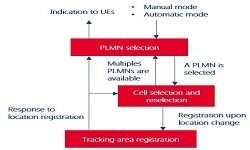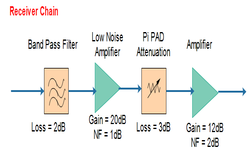LTE Layer 1 (Physical Layer) Interview Questions
- What is the smallest time measurement unit Ts in LTE? Show the calculation. How many Ts are there in 1 subframe?
- In normal cyclic prefix, what is the length of the 0th and 1st symbol CP in Terms of Ts? How is the length of total time if all 7 CPs are added together in a time slot in terms of Ts and seconds?
- In extended CP. How many resource elements are there in a Resource Block?
- In DL, How many RS symbols are there in a normal RB in case of 2×2 MIMO?
- What is the difference between OFDMA and SC-FDMA? Why OFDMA is not used in both the directions?
- What are the 3 parameters, based on which scrambling code is generated?
- Cell ID, Reference Signal and?
- How many Maximum bits are there for PUCCH of format 1/1a/1b and 2/2a/2b each and they are spread in how many symbols?
- In a group hopping, how many hopping patterns are there and how many sequence shift-patterns?
- How many PUSCH DMRS RE’s are there in a RB in a subframe?
- How many DMRS are there in a RB in a PUCCH of type 1/1a/1b and of type 2/2a/2b?
- Which symbol locations are occupied for DMRS in a PUCCH of type 1 and type 2? (Start counting from 0).
- Which Channels/Signals are relevant only in Physical layer and they are not needed and not mapped in Transport or Logical Channels. List them for DL and UL separately.
- What is a preamble format? How many types are there? Explain when which type of format is suitable?
- What is the length of preamble sequence in bits and how many RB’s are required to send?
- Preamble sequence is of 6 Bits which makes total preamble 2^6=64. 6 RBs are required to send it.
- What is the smallest and largest RB size in LTE and how much Mhz bandwidth does that correspond to?
- What is REG?
- What is CCE? How many CCE’s are required to carry PDCCH? Explain different configurations.
- What are Cyclic delay diversity (CDD) and spatial diversity and difference between them?
- What is CSI and what are the values transmitted as CSI?
- CSI stands for Channel State Information. It is sent in uplink by UE to eNodeB. The CSI parameters are Rank Indicator (RI), Channel Quality Indicator (CQI) and Precoding Matrix Indicator (PMI)
- What is UE specific reference signal and when/how is it used?
- What is SRS and where is it physically mapped? Explain.
- What is DCI? What is sent in DCI format 0?
- What is CFICH and where is it mapped? How many symbols and REGs does it occupy?
- What is PHICH and how many REGs does one PHICH occupy and where in the DL Physical Resource?
- How many mobiles PHICH can be sent in the same symbol and how are they multiplexed?
- How many types of Ref Signals are transmitted in DL? Mention and explain.
- How many types of Ref Signals are transmitted in UL? Mention and explain.
- How is PHICH and CFICH allocated in different cells so that they avoid interference. Show it pictorially to explain.
- In case of 4×4 MIMO, how many reference signals are there in an RB? What is the %tage occupied by Ref signals in this case?
- What is MBSFN and MBSFN region?
- What is PSS and SSS? What information is derived out of these signals? Where are they mapped in Physical resources?
- Where is PBCH mapped? How many RB’s do they occupy?
- What si the minimum bandwidth required for LTE system and why?
- Which are the Physical channels UCI and DCI are sent?
- What is the valid CRC length in bits?
- For a buffer of length 6140 from MAC (TTI), what is the number of segments? Why?
- Describe briefly how, where and how many padding “0” bits are inserted in code segmentation.
- Which channel case Turbo coding is used? And which channel case Bit Repetition Coding is used?
- What is the smallest and biggest segment size for Encoding?
- For Turbo Encoder – If block size is 80, what is the number of output bits?
- For Convolutional Encoder- If block size is 80, what is the number of output bits?
- What is Trellis Termination for Turbo Encoder? How many bits are additional terminated with and with which streams?
- Total Number of bits G and mapped onto G’=G/(L*M) symbols. What is L and M?
- For Turbo coding rate matching, data block is to be spread in how many columns?
- What is the control information multiplexed with data of PUSCH? And what are the control information interleaved together with PUSCH?
- How many Symbols are used for PUSCH in a SRS subframe per subcarrier, including multiplexed CQI.
- What is the control information encoded in UCI (PUCCH)?
- Can control information be sent on PUSCH without UL-SCH data?
- What is the CRC length, total number of segments, Encoder type and Modulation for PBCH?
- For DL-SCH, PMCH and PCCH, what is CRC length, number of segments, Encoder type and modulation?
- What is the CRC length for CFICH and HICH respectively? What kind of encoder is used for them?
- What is Q(in) and Q(out) in Radio Link Monitoring process? Explain each in 1 sentence.
- For RAR, how many bits is TA? If the TA is 25 in the RAR, what is the TA adjustment required in microseconds?
- How many bits is TA adjustment for non-RAR. If the TA value is 25(decimal), how much milli/ microsecond timing is to be adjusted? Is the timing to be increased or decreased?
- Normally, when should the TA adjustment should take place, if you receive it in subframe x?
- If you receive a Scell Activation or De-activation in subframe x, when should that be effective?
- What is EPRE? In EPRE calculation what is the relationship with Cyclic Prefix?
- What are the main factors in calculation of Power for PUSCH? List them.
- What is TPC and TPC accumulation? What is the max accumulation(dbm) value in both +ve and -ve direction?
- Range of TPC can be from
- What is power headroom and Power scaling factor?
- Cell Parameter P(B) is denoted by ρ(B)/ρ(A). What are these 3 parameters w.r.t. symbol EPRE? What is the maximum?
- List the parameters UE must have before Random Access?
- What are the factors which determine the initial RA power?
- After getting RAR, What do you send to eNB and after how long delay?
- If you do not receive RAR within RAR window, after/before what delay would you retransmit?
- What is the significance of “UL delay” and “hopping flag” in RAR?
- What is the max number of DL HARQ processes for FDD and TDD in UL/DL both?
- What is Transmit Diversity and Cyclic Diversity? Explain each in a sentence.
- Explain difference between Resource allocation type 0 and 1?
- What is RBG(Resource Block Group) and size of each RBG?
- What are the parameters defining the TBS size?
- What is the minimum (with minimum modulation) and Maximum(with maximum modulation) TBS (Transport Block Size) for one layer.
- If for single layer TBS size is “X”, will the TBS size be n.X for n layers? Why?
- What is RV (redundancy version)?
- What is CSI elements? What is Periodic and Aperiodic CSI? In which case PUCCH and PUSCH is used?
- What is TTI Bundling? Max how many MACs can be configured for this?
- What are PMI and RI?
- For every subframe of PUSCH/PDSCH, when/how is the (N)AKnowledhement sent?
- What is RNTI? List the types of RNTI (with their default values, if any).
- What is Sounding Procedure? Explain briefly. What are parameters defining SRS?
- What is the difference between type 1 and type 2 hopping?
- What is difference between intra-subframe and inter-subframe?
- What is the difference between BPSK, QPSK,16QAM and 64QAM. Describe briefly.
- Ans= All these are digital Modulations BPSK can carry one bit per symbol
- OPSK can carry two bits per symbol, 16 QAM four bits per symbol and 64 QAM carry 6 bits per symbol.
- What are the 4 configurations of CCE? How will you find number of PDCCH accomodatable in a subframe?
- What is Common and UE-Specific Search Space?
- How is PHICH assigned on the control region?
- How is CFICH assigned in the control region?
- Where are DMRS mapped on the PUSCH RB in a subframe?
- What is cyclic shift and how is it used for PHICH or other control information among UE’s?
- What is the spreading factor used for PHICH after repeat encoding and what is the total symbols occupied?
- What is semi-persistent scheduling? How is it utilised w.r.t. Scheduling Requests?
- How many bits are used to send SR in PUCCH? How is SR sent and multiplexed with other control information?
- How many users PDCCH can be multiplexed for format 1 and format 2 respectively on the same physical resource?
- In rel-10 how many antenna max assumed for UE and eNB?
- How many types of reference signals are there in Downlink? List them.
- In case of 4 antennas with 4x4MIMO, maximum how many codewords and layers can be configured?
- How do you get the Physical Cell ID from eNB even without reading BCH?
- Explain why a mobile with speed more than 500Km/Hour will fail to remain connected with LTE? What is the limit?
Related Posts:
- LTE Layer 1 (Physical Layer) Interview Questions
- LTE Layer 2 (MAC,RLC,PDCP) Interview Questions
- LTE Layer 3 (RRC Layer) Interview Questions



